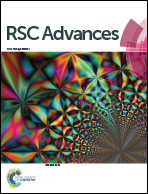PET governed fluorescence “Turn ON” BODIPY probe for selective detection of picric acid†
Abstract
The non-fluorescent meso diaminophenyl 1,3,5,7-tetramethyl BODIPY dye has been investigated and employed for picric acid sensing in a constructive way by regenerating its fluorescence through PET hindrance. A strong enhanced emission signal was obtained as a consequence of the electrostatic association between the BODIPY probe and picric acid with specific recognition among other explosive nitroaromatics. The probe shows a 1 : 1 binding stoichiometry with picric acid and a detection limit of up to 0.65 ppb.


 Please wait while we load your content...
Please wait while we load your content...